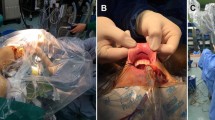Abstract
To evaluate the outcome and initial hurdles of transaxillary robotic thyroidectomy in the Indian subcontinent. A total of seven (n = 7) patients were operated from August 2016 to February 2017. Ultrasonography was used as a tool to decide the size of thyroid lobe and fine needle aspiration cytology for the type of lesion. All patients underwent ipsilateral brachial plexus nerve conduction studies preoperatively. Two arm positions were evaluated. The robot was docked at the contralateral side of the surgical field. Before discharge from hospital, all patients were given a questionnaire evaluate outcome. Set 1 was answered on the day of discharge and Set 2 at one-month follow up. The most common pathology in our case series was colloid goiter (n = 4) followed by follicular lesion (n = 3). The mean console time was 167 min, with initial two cases taking more than 200 min. The maximum and minimum length of the axillary tunnel was 16 and 27 cm respectively. There was no difference with regard to complication rate with either arm position. None of the patients developed brachial plexus injury and was confirmed by normal nerve conduction study done on postoperative day three. In our experience with transaxillary robotic thyroidectomy, the problems we faced in our population were unique considering the varied physical parameters. Use of malleable retractors comes handy in these situation and we recommend the use of these over the rigid ones. Though both the arm positions had similar outcomes, the one with sideways position was more favorable.






Similar content being viewed by others
References
Rabinovics N, Aidan P (2015) Robotic transaxillary thyroid surgery. Gland Surg 4(5):397–402
Wilson MN (2014) Modification of two-incision trans-axillary robotic thyroidectomy. J Robot Surg 8:325–327
Aliyev S, Taskin HE, Agcaoglu O, Aksoy E, Milas M, Siperstein A, Berber E (2013) Robotictransaxillary total thyroidectomy through a single axillary incision. Surgery 153(5):705–710
Hockstein NG, Gourin CG, Faust RA, Terris DJ (2007) A history of robots: from science fiction to surgical robots. J Robot Surg 1(2):113–118
Kalan S, Chauhan S, Coelho RF, Orvieto MA, Camacho IR, Palmer KJ, Patel VR (2010) History of robotic surgery. J Robot Surg 4(3):141–147
Kang SW, Lee SC, Lee SH, Lee KY, Jeong JJ, Lee YS, Nam KH, Chang HS, Chung WY, Park CS (2009) Robotic thyroid surgery using a gasless, transaxillary approach and the da Vinci S system: the operative outcomes of 338 consecutive patients. Surgery 146(6):1048–1055
Maan ZN, Gibbins N, Al-Jabri T, D’Souza AR (2012) The use of robotics in otolaryngology-head and neck surgery: a systematic review. Am J Otolaryngol 33(1):137–146
Duh QY (2011) Robot-assisted endoscopic thyroidectomy: has the time come to abandon neck incisions? Ann Surg 253(6):1067–1068
Kandil E, Abdelghani S, Noureldine SI, Friedlander P, Abdel Khalek M, Bellows CF, Slakey D (2012) Transaxillary gasless robotic thyroidectomy: a single surgeon’s experience in North America. Arch Otolaryngol Head Neck Surg 138(2):113–117
Landry CS, Grubbs EG, Morris GS, Turner NS, Holsinger FC, Lee JE, Perrier ND (2011) Robot assisted transaxillary surgery (RATS) for the removal of thyroid and parathyroid glands. Surgery 149(4):549–555
Lang BH, Wong CK, Tsang JS, Wong KP, Wan KY (2015) A systematic review and meta-analysis evaluating completeness and outcomes of robotic thyroidectomy. Laryngoscope 125(2):509–518
Rodriguez FN, Low RA, Singer JA, Bornstein AM, Bradford Doxey J, Hashimoto LA, Rassadi R, Dolce CJ, Hollingworth A, Hayes C 3rd, Shively CJ (2011) A new technique for robotic thyroidectomy: “the DaVinci gasless single-incision axillary approach”. J Robot Surg 5(3):157–162
Luginbuhl A, Schwartz DM, Sestokas AK, Cognetti D, Pribitkin E (2012) Detection of evolving injury to the brachial plexus during transaxillary robotic thyroidectomy. Laryngoscope 122(1):110–115
Alkan U, Zarchi O, Rabinovics N, Nachalon Y, Feinmesser R, Bachar G (2016) The cause of brachial plexopathy in robot-assisted transaxillary thyroidectomy—a neurophysiological investigation. Laryngoscope 126(9):2187–2193
Kim JH, Park JW, Gong HS (2014) Axillary web syndrome after transaxillary robotic thyroidectomy. J Robot Surg 8(3):281–283
Tae K, Song CM, Ji YB, Kim KR, Kim JY, Choi YY (2014) Comparison of surgical completeness between robotic total thyroidectomy versus open thyroidectomy. Laryngoscope 124(4):1042–1047
Author information
Authors and Affiliations
Corresponding author
Ethics declarations
Conflict of interest
There is no conflict of interest between authors and there was no funding agency/source involved in this study.
Informed consent
An informed consent was obtained before including the patients in the study.
Ethical approval
The Departmental Ethical Committee gave ethical clearance for the study.
Electronic supplementary material
Below is the link to the electronic supplementary material.
Rights and permissions
About this article
Cite this article
Gupta, A.K., Kumar, A., Singh, A. et al. Robot Assisted Trans Axillary Thyroidectomy: A Subcontinent Experience. Indian J Otolaryngol Head Neck Surg 70, 366–373 (2018). https://doi.org/10.1007/s12070-018-1357-9
Received:
Accepted:
Published:
Issue Date:
DOI: https://doi.org/10.1007/s12070-018-1357-9




